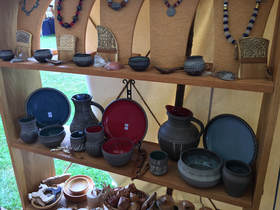
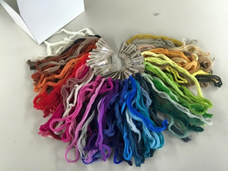
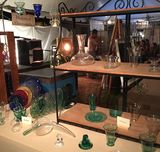
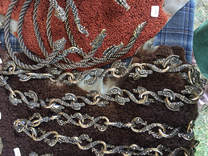
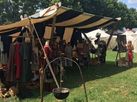
| A Wandering Elf |
|
|
The Holidays are upon us and I thought I would share some ideas of things the Viking Age reenactor in your life might enjoy as gifts (and, of course, the wonderful vendors from whom you can purchase these items).  Feed the Ravens is quite possibly my favorite vendor ever. I love the exceptionally high quality leather work and pottery that they craft and the assortment of jewelry and tools that they carry. They also often have unique items that one rarely sees elsewhere. Currently in stock they have period blacksmith tools, brass chain for suspending tools from brooches, reindeer antler drop spindles (I have two of these that are my favorites for spinning flax), and jewelry! They also have leather goods and pottery. I recommend talking directly to Maggie or Scot about what they have now or perhaps to place a special order for the exact item that the Viking in your life has been coveting. (And yes, I confess, this is my personal favorite vendor ever!)  Timeless Textiles sells EPiC wool yarn. This is a 2/18 wool yarn, dyed dozens of wonderful colors, that is very smooth and quite strong. I find that this works exceptionally well for both tablet weaving and for use on other types of looms. Unlike some other brands of similarly sized yarn, this is a true worsted spin and does not have little flyaway hairs that will cause your warp to bind up. They even sell a sample pack of swatches so that your favorite weaver can keep it on hand for project planning. (And bonus, they also sell Bocken's linen thread in colors! This is great for hand sewing.)  Historical Glassworks, this artisan carries glassware that represents numerous time periods and locations, from Roman, to Viking and into the Renaissance (and later)! They also have a wonderful selection of handmade gifts that can appeal to those who are not interested in recreating the past. Their holiday ornaments, candle sticks and glass bracelets immediately come to mind as beautiful items that many would enjoy.  Crafty Celts, well, what can I say beyond the fact that I have long been a fan of this vendor. Do you need a new Knight's chain? Celtic animal pendants or brooches? Bracelets (that, honestly, look just as great outside of a historic setting as they do inside)? Also, this is the vendor to hit up if your Secret Santa target is a fan of the History Channel's "The Vikings" as they supply much of the jewelry used in the show.  The Practical Viking is a really cool shop to visit at Pennsic. They provide a great atmosphere and sometimes even have dyeing demos or other happenings in their booth. They carry an assortment of items that appeal to Vikings such as hoods, legwraps, cool cookware and even adorable Viking dolls! Oxbow Books is not a vendor of handcrafted items, but rather is a publisher of academic books. They carry many of the volumes that help the us piece together the past. Most reenactors that I know have a long list of books on their wishlists, so it might be worth seeing what they would love to read next and purchase that as a gift. (Note that they also have a fantastic section of sale books that can be a real bargain.)
1 Comment
I think anyone that has poked around my blog realizes that I love compiling data for archaeological finds. I can spend months digging through all of my materials for instances of cord sewn to edges or looking for stripes and plaids in textiles. I have dozens of excel sheets set up for any number of topics (from embroidery to tablet weaving to tapestry to width of hems) to collect information as I read because eventually I will have enough of the sources covered that I can publish some useful information on it here (or add it to one of my classes).
This week a friend told me she was urged to start a survey of a certain practice in period and here is the advice that I offered: Define To start, I recommend you sit down and work out the exact definition of the item is for your study. If you are doing embroidery, for example, what would qualify in terms of your survey? Would the stickerie metal work at Birka count? Would a single like of stem stitch across a hem count? Are you doing figurative motifs only or more simple as well? If you are doing tablet weaving, are you only counting metal brocade, or will it be all tablet weaving? Do starting borders from a warp-weighted loom count or are you only collecting information on bands? Timeframe Next you need to define your time. Viking Age (by which definition)? Iron Age (which definition/culture)? A solid set of years (example 500-1000CE, or 100-1000CE, or just 9th and 10th century)? Location (or Culture) Then determine geography... British Isles, Northern Europe, Eastern Europe, all of Europe? What do you do with pieces that might have been moved across borders. Do you count it based on likely origin or where it was found? If the item you are studying is Saxon, are you looking at those items that were stolen and traded elsewhere, or just those within the British Isles. Keep Notes Once you have all that I highly recommend you start an excel sheet to keep a list of each item, making columns for the most relevant things (date of item, culture it originates from, stitch types, ground cloth, fibres used, colors, whatever, size of piece, whatever it is). Make sure you have a column there for the source of your data as well and keep a bibliography with it. Sometimes I also keep a powerpoint for a category where I drop pictures and relevant data (and a note about the source) on each slide. Later I can print these if necessary and shift through them to try to make sense of what I have. (And beyond that, I made notes on the source documents themselves in Mendeley.com) Context And then there is the absolutely most important thing when it comes to a survey.... context. How was this thing used historically? Who used it? What was their status? Was it home goods, decoration or clothing? If you want to make resource that others can use as well and nothing is more valuable than that bit of information. An embroidery that was used as part of an ecclesiastical covering does would not be appropriate for lower class clothing. Metal thread tablet weaving is very different in context than a starting border for a piece of cloth. A coin repurposed as a pendant has a different significance than loose coins. Context lets others know whether the item might or might not be applicable to the persona/kit they are building. Remember that you can always go back and change or add parameters to your survey later. For example, if you set your dates to 9th and 10th century and British Isles only then discover many examples in the 8th century that heavily relate to your initial material, you can expand on your original plan. You can also keep notes of things that might not fit the survey, but that are still relevant in some way and add them as peripheral evidence if that applies. Another good one that complements my previous post regarding the role and rights of women in the Viking Age, "Polygyny, Concubinage, and the Social Lives of Women in Viking-Age Scandinavia": https://rafhladan.is/bitstream/handle/10802/15597/j.vms.5.114355.pdf?sequence=1 And below is another in the series of Leszek Gardeła's videos: There are a few topics that I have discussed at length with friends or online on forums, have only very briefly brought up here due to lack of time to properly dedicate to a decent response. I finally think I need to share some information on one of the major hot points right now, that of the Viking Warrior woman. I am going to start to say that I think that the authors of the paper that invoked a media frenzy last year did a very, very poor job in naming their study. "A female Viking Warrior confirmed by genomics" took another look at a Birka grave that was given a "warrior burial" (Bj581). The headline is misleading at best (and the paper does not really deal with some of the other issues that come up when looking at Birka). Part of the problem here is that there is an assumption that everything in a grave might have been something used by the interred while they were alive. The reality is that we really don't know that, in many cases. What we can say is that the items in a grave actually say something about those left behind. It might be a case where a favorite tool was buried with the individual, but it could just as well be that the things put in the grave were displays of station or status. It could be memorabilia from loved ones, reminders or keepsakes. Remember too that there are cases of small children being buried with tools or weapons that they would have been too young to use. Does that mean that a little girl was a master seamstress or that a young boy was also a warrior? Further, I have seen people screeching that it is sexist to declare that Bj581 was NOT a warrior grave now that we see DNA evidence that the bones are female. In actuality, I think that it is sexist to declare MALE graves with weapons were warriors without some other proof that they held that role in life (such as trauma to the skeleton). There is this modern desire to prove female empowerment in a past that goes even beyond some of the ideas fed to us by Victorian fantasy (and the number of memes promoting the "equality" of men and women in Viking culture is further proof of this). This sort of desire feeds the media frenzy that causes research papers like this to make international headlines. An example of the above is a piece of research that came out a few years back. The study confirmed that half of the graves from a site in England were female. What was reported in the news was "50% of Viking Warriors were women". In reality, half the very small sample - 13 graves - were determined to be female. In this case, the report itself was not misleading, as it declares half of the MIGRANTS were female. That is a very different thing than the (horrific) journalism that started plastering headlines about half of Vikings being women. You can read more about the controversy in the two articles below (the original paper is here):
That aside, there are other issues that need to be looked at here. Judith Jesch, Professor at the University of Nottingham and author of Women in the Viking Age, has a very detailed post on her thoughts about this grave and it (as well as some of the commentary under it) is worth a read. norseandviking.blogspot.com/2017/09/lets-debate-female-viking-warriors-yet.html Beyond everything I have listed above, other issues come up regarding Bj581, including the fact that the original grave was excavated a long time ago and there have previously been issues with grave contents not being properly marked (meaning that the bones could possibly even belong to another grave). Some of the issues with this are mentioned in this paper: www.academia.edu/34564381/FEMALE_VIKING_REVISED If you are interested in following some exceptional, current, research on the topic of warrior women in the Viking Age I recommend that you look up Dr. Leszek Gardeła, who is heading up an impressive project. uni-bonn.academia.edu/LeszekGardela The paper I consider most important in this field is his "Amazons of the North? Armed Females in Viking Archaeology and Medieval Literature". I recommend that you get in touch with your local library and request this item via inter-library loan immediate. It is a very comprehensive collection of evidence (iconography, archaeology, and textual) and discusses the possible drawbacks with each item and applies better context than you often see in battles waged online. Again, if this topic is of serious interest to you, you really need to get a copy of this paper. https://www.degruyter.com/view/books/9783110569483/9783110569483-024/9783110569483-024.xml?fbclid=IwAR25uqZ5Nno1I98RBiWIhWCOWlJp89phvWEBABqkWi0qlAzZ3TksZ3--UqM Below is a video about Gardeła's project. I very much look forward to the next in the series. Edited to add: I just read this paper and feel the need to include it in this discussion as well given that it addresses several of the things I mentioned above: https://www.academia.edu/36569707/Vikings_History_and_the_Search_for_Ourselves_SASS_talk_May_2018?fbclid=IwAR0D05ECQueSuUbguXK-TlTiTOFcpUzeHLljOireHoBNksYyRuGUxVjX73o |
About Me
I am mother to a billion cats and am on journey to recreate the past via costume, textiles, culture and food. A Wandering Elf participates in the Amazon Associates program and a small commission is earned on qualifying purchases.
Archives
July 2024
Categories
All
Blogroll of SCA & Costume Bloggers
Below is a collection of some of my favorite places online to look for SCA and historic costuming information.
More Amie Sparrow - 16th Century German Costuming Gianetta Veronese - SCA and Costuming Blog Grazia Morgano - 16th Century A&S Mistress Sahra -Dress From Medieval Turku Hibernaatiopesäke Loose Threads: Cathy's Costume Blog Mistress Mathilde Bourrette - By My Measure: 14th and 15th Century Costuming More than Cod: Exploring Medieval Norway |